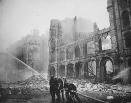by
|
The History of London
The Twentieth Century |
|||||||||||||||||||||
London grew even bigger in the twentieth century. Many more people went to live in the city suburbs and travelled to work by train, bus or car. The city changed too, with new buildings replacing those damaged by bombs during the war years. The First World War The First World War began in 1914. The first air raid hit London on 1915 and during the war over 835 people were killed in air attacks.
In 1939 the Second World War broke out and some 690,000 children were moved out of London. The blitz began in 1940 and caused a lot of damage to London, with some of
the worst damage being done around (and including) St Paul’s Cathedral. By the end of the war 30,000 people had been killed in London and much of the city’s buildings lay in ruins. Later in the twentieth century, air travel became more important. New airports were built to link London with the rest of the world. Millennium London At the start of the new millennium, London continues to grow. It now has a population of over seven million, making it by far the biggest city in Britain. The start of the millennium has been marked by the building of many new attractions and exhibitions, so there is more to see and do in London than ever before.
|
|||||||||||||||||||||
 © Copyright – please read © Copyright – please read All the materials on these pages are free for homework and classroom use only. You may not redistribute, sell or place the content of this page on any other website or blog without written permission from the . |
© Copyright 2013
is the creator of the Woodlands Resources section of the Woodlands Junior website.
The two websites projectbritain.com and primaryhomeworkhelp.co.uk are the new homes for the Woodlands Resources.
left Woodlands in 2003 to work in Kent schools as an ICT Consulatant.
She now teaches computers at The Granville School and St. John’s Primary School in Sevenoaks Kent.
Woodlands Junior Homework Help new website





 The Second World War
The Second World War